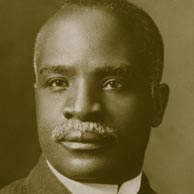Role model for future heroes
With a train ticket in hand and dreams in mind, Kelly Miller headed north from South Carolina in 1880 and into a life as a successful mathematician, college dean, author and education advocate. Along the way, he became Johns Hopkins University’s first black student. Born in 1863 to a free man and a slave woman, Miller drew inspiration from what he saw as his own “band of heroes,” northern teachers who had come south to teach black children after the Civil War. A scholarship allowed Miller to attend Howard University, which in turn led to a part-time job with prominent mathematician Simon Newcomb.
After Newcomb became a Johns Hopkins faculty member, Miller sought his assistance in pursuing graduate studies at the university. His application to graduate school in 1887 prompted the college president and trustees to consider the founder’s Quaker background and his commitment to a hospital and university open to all. Miller’s application served as a mirror, forcing university leadership to confront their values and principles, and though there would be many years between Miller and the next black student, Miller’s admission helped open the door for all students of color at Johns Hopkins.
Although financial circumstances prevented Miller from completing a JHU degree, he returned to Howard, earned a master’s degree and a law degree, and built an illustrious career. Never forgetting his “band of heroes,” Miller himself became one, a tireless supporter of quality education for blacks. He died in 1939.
